Watercolor artist Zan Lombardo draws attention to mangroves with painting and sonnets
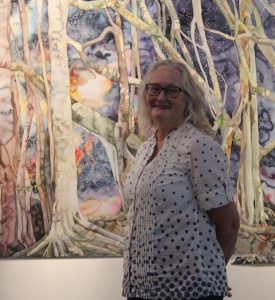 Zan Lombardo is not just a watercolor artist given to whimsical, dreamlike natural imagery. She is also a poet and inveterate storyteller. And one of the subjects that causes Lombardo to wax poetic are the mangroves that populate the coastlines along Matlacha and Pine Island. In fact, Zan devoted nine months of her life during the COVID-19 quarantine in 2020 to rendering a painting of her beloved mangroves and crafting a series of 15 sonnets that express their importance as rookeries for fish, crustaceans, shellfish and brown pelicans, roseate spoonbills and a legion of other wildlife.
Zan Lombardo is not just a watercolor artist given to whimsical, dreamlike natural imagery. She is also a poet and inveterate storyteller. And one of the subjects that causes Lombardo to wax poetic are the mangroves that populate the coastlines along Matlacha and Pine Island. In fact, Zan devoted nine months of her life during the COVID-19 quarantine in 2020 to rendering a painting of her beloved mangroves and crafting a series of 15 sonnets that express their importance as rookeries for fish, crustaceans, shellfish and brown pelicans, roseate spoonbills and a legion of other wildlife.
There are 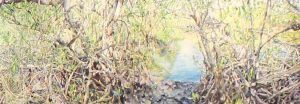 more than 50 species of mangrove worldwide, but just three in Southwest Florida – black, red and white. All three are featured prominently in an intricately-painted composition that adorns one
more than 50 species of mangrove worldwide, but just three in Southwest Florida – black, red and white. All three are featured prominently in an intricately-painted composition that adorns one 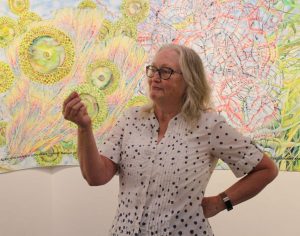 wall of the Alliance for the Arts’ main gallery.
wall of the Alliance for the Arts’ main gallery.
“I took a panoramic photo and worked from that, one square foot at a time,” Zan discloses. Lombardo normally doesn’t adhere to a timetable for completing her compositions. In fact, Everything Is Indeed Reaching Out to Everything Else was a labor of love that took six years to complete. But for her mangrove painting, she was determined to finish the work 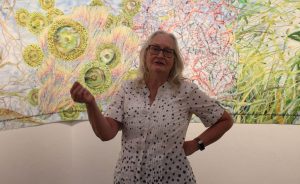 in just nine months.
in just nine months.
“I challenged myself to finish five square feet every month, one square foot each week, and 2½ square inches every day for nine months,” says Zan, who also worked in 16 free days for Thanksgiving, Christmas and those rare instances where she just was not inspired to paint.
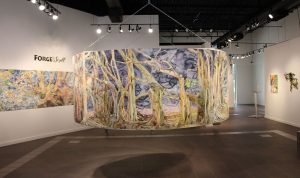 “I learned so much about mangroves that I was inspired to write fifteen sonnets about mangroves,” Zan adds. “Most people think that mangroves a just a nuisance that blocks the sunsets. What they don’t get is estuary/habitat part of it. Hence the sonnets.”
“I learned so much about mangroves that I was inspired to write fifteen sonnets about mangroves,” Zan adds. “Most people think that mangroves a just a nuisance that blocks the sunsets. What they don’t get is estuary/habitat part of it. Hence the sonnets.”
Of the three 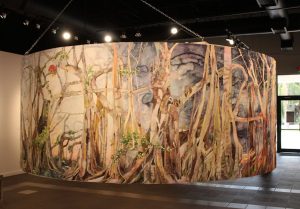 species found in Southwest Florida, the red mangrove is the best known. It’s an evergreen that grows to 25 meters in height. They the ones you’ll typically find growing along the water’s edge. Their tangled reddish roots, called prop roots, have earned red mangroves the title of “walking trees.“ The roots not only help stabilize the tree, they contain a waxy substance that helps keep salt out.
species found in Southwest Florida, the red mangrove is the best known. It’s an evergreen that grows to 25 meters in height. They the ones you’ll typically find growing along the water’s edge. Their tangled reddish roots, called prop roots, have earned red mangroves the title of “walking trees.“ The roots not only help stabilize the tree, they contain a waxy substance that helps keep salt out. 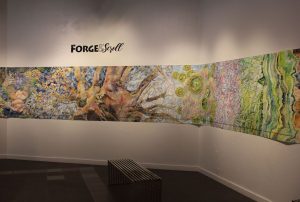 But when salt gets in anyway, the tree deposits it in older leaves, which the tree then sheds.
But when salt gets in anyway, the tree deposits it in older leaves, which the tree then sheds.
Red mangroves have seeds that look like green beans. Known as “monkey whistles,” the seed pods are actually just a single seed inside the conical fruit that forms a long, narrow root that can grow up to 20 centimeters in length before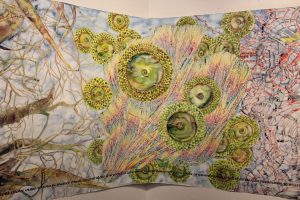 it detaches from the mother plant and falls to the ground. Red mangroves are very sensitive, and if more than 50 percent of the leaves are detached from the tree (as in a hurricane), it will die. The wood can be converted into a good quality charcoal and the bark produces high-quality tannin that can be used for leather work, as Matlacha’s early settlers found as they put down their own
it detaches from the mother plant and falls to the ground. Red mangroves are very sensitive, and if more than 50 percent of the leaves are detached from the tree (as in a hurricane), it will die. The wood can be converted into a good quality charcoal and the bark produces high-quality tannin that can be used for leather work, as Matlacha’s early settlers found as they put down their own 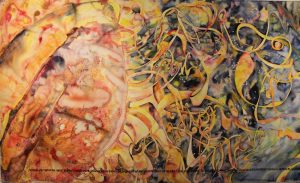 roots on The Fill in the years following the 1929 stock market crash that gave rise to The Great Depression.
roots on The Fill in the years following the 1929 stock market crash that gave rise to The Great Depression.
Black mangroves are typically found in slightly higher elevations upland from the red mangrove. They also reside in areas of high salinity. To counteract this, the tree has developed tubular bristles 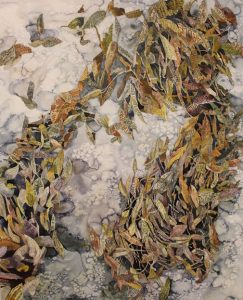 that protrude from the soil all around the tree‘s trunk. The bristles trap oxygen and send it to other parts of the tree. It has green pod-like seeds which are edible, but if they are not properly prepared, they can be toxic.
that protrude from the soil all around the tree‘s trunk. The bristles trap oxygen and send it to other parts of the tree. It has green pod-like seeds which are edible, but if they are not properly prepared, they can be toxic.
White mangroves are the shortest (15’) and have no visible aerial roots. You’ll usually find them in the back of a mangrove swamp, away from the tide. The easiest way to identify them is by their light yellow-green elliptical leaves which have two glands at the base of the leaf blade where the stem starts. These glands enable the tree to release salt, and it’s the speckled white salt crystals that form on the leaves that gives the 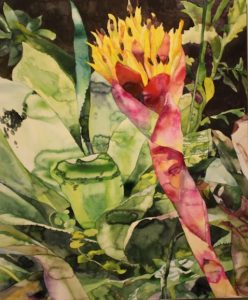 tree its name.
tree its name.
As mentioned, mangroves provide protected nursery areas or rookeries for an abundance of wildlife. That wildlife, in turn, provides food for snook, snapper, tarpon, jack, sheepshead, red drum, oysters and shrimp. Eliminate mangroves and you eliminate the food source for all of the sport fish for which this part of the country is known.
And that’s a secret that Zan Lombardo wants more people to know.
The painting is just one part of that process.
 The sonnets are another.
The sonnets are another.
“With each sonnet, the last line becomes the first line of the next sonnet and the 15th sonnet is all the first lines put together,” Lombardo teases. “Plus there’s another epic poem 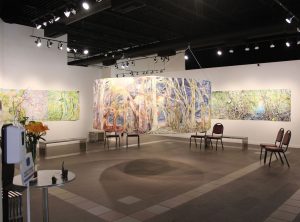 by a Pennsylvania storyteller that’s all about all the wildlife that a mangrove supports.
by a Pennsylvania storyteller that’s all about all the wildlife that a mangrove supports.
You can join Zan Lombardo for an hour of poetry and education about the mangroves and her 15-foot watercolor that’s on display at the Alliance for the Arts in its Forge and Scroll Exhibit. Attendees will come away knowing more about the mangroves than they ever 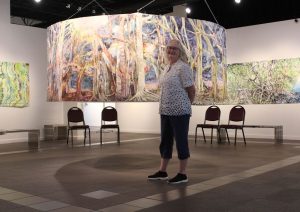 thought possible. Mangroves as Poetry takes place at 5:00 p.m. on Friday, September 24. Admission to the gallery is free and open to the public, but a $5 suggested donation helps keep arts programming accessible.
thought possible. Mangroves as Poetry takes place at 5:00 p.m. on Friday, September 24. Admission to the gallery is free and open to the public, but a $5 suggested donation helps keep arts programming accessible.
September 22, 2021.














 Tom Hall is both an amateur artist and aspiring novelist who writes art quest thrillers. He is in the final stages of completing his debut novel titled "Art Detective," a story that fictionalizes the discovery of the fabled billion-dollar Impressionist collection of Parisian art dealer Josse Bernheim-Jeune, thought by many to have perished during World War II when the collection's hiding place, Castle de Rastignac in southern France, was destroyed by the Wehrmacht in reprisal for attacks made by members of the Resistance operating in the area. A former tax attorney, Tom holds a bachelor's degree as well as both a juris doctorate and masters of laws in taxation from the University of Florida. Tom lives in Estero, Florida with his fiancee, Connie, and their four cats.
Tom Hall is both an amateur artist and aspiring novelist who writes art quest thrillers. He is in the final stages of completing his debut novel titled "Art Detective," a story that fictionalizes the discovery of the fabled billion-dollar Impressionist collection of Parisian art dealer Josse Bernheim-Jeune, thought by many to have perished during World War II when the collection's hiding place, Castle de Rastignac in southern France, was destroyed by the Wehrmacht in reprisal for attacks made by members of the Resistance operating in the area. A former tax attorney, Tom holds a bachelor's degree as well as both a juris doctorate and masters of laws in taxation from the University of Florida. Tom lives in Estero, Florida with his fiancee, Connie, and their four cats.